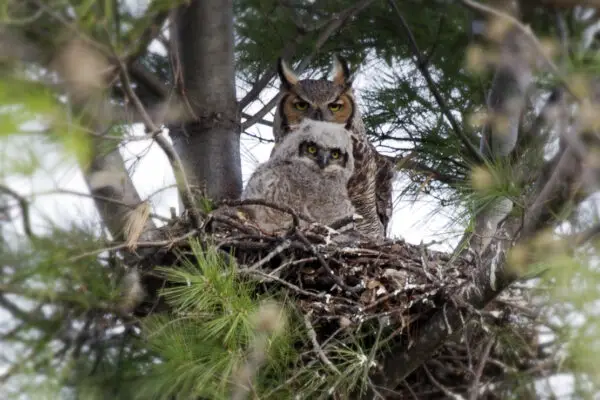Any landscape comes to life with the sound of birdsong and wing flashes. But it might seem disturbingly silent when you notice all of a sudden that there are no birds in your surroundings. This article addresses the deeper significance and possible reasons of this uncomfortable phenomena if you’ve seen a decline in birds and wondered “what does it mean when there are no birds around?”
In summary, declining bird numbers in a region may be caused by a number of reasons, including habitat loss, pollution, climate change, and more. Additionally, the lack of birds may indicate a desire for greater happiness, freedom, and communication in your own life.
You may call their flying knowledge back by taking steps to assist local bird conservation and foster your own spiritual development.
Reasons for Birds’ Disappearance in the Ecosystem
The sight and sound of birds in the skies is one of the most uplifting sights there is. Nonetheless, a notable decrease in bird numbers has been seen by several individuals in the last few years. Concerns over the condition of our ecosystems and possible repercussions for biodiversity are raised by this.
The extinction of birds is caused by a number of ecological reasons, such as illnesses and invasive species, pollution and pesticides, extreme weather and climate change, habitat loss and fragmentation, and pollution.
Loss of Habitat and Fragmentation
The loss and fragmentation of habitat is one of the main causes of the fall in bird populations. Natural ecosystems are disappearing at an alarming pace as metropolitan areas grow and human populations rise.
Wetlands are being drained, forests are being cleared, and grasslands are being turned into farmland. Due of these alterations, there are fewer locations for birds to migrate, nest, and feed, which causes their population to drop.
Extreme Weather and Climate Change
Bird disappearances are also largely caused by extreme weather and climate change. Bird migratory patterns may be disrupted, food supply can be changed, and nesting sites can be destroyed by rising temperatures, shifting precipitation patterns, and an increase in the frequency of severe weather events.
For instance, changes in the springtime schedule may cause a discrepancy between the peak bug availability and the arrival of migrating birds, which may hinder the birds’ capacity to procreate.
Pesticides and pollution
The usage of pesticides and pollution both negatively impact bird populations. Chemical pollutants that may build up in the bodies of birds include heavy metals and poisons from industrial processes. These pollutants can cause reproductive issues, immune system weakness, and even death.
Agriculture-related pesticides have the potential to pollute food and water sources, which may have a direct or indirect impact on birds by disrupting the populations of their prey. Reduced reproductive success and a general population reduction may arise from this.
Disease-causing Invasive Species
A danger to bird populations also comes from illnesses and invasive species. Invasive species have the ability to upset food chains, outcompete local birds for resources, and even feed on bird eggs and nestlings.
Furthermore, illnesses like the West Nile virus and avian influenza may spread quickly across bird populations and cause catastrophic deaths. The variety and number of bird species in the impacted regions may be greatly impacted by these variables.
What Happens When Birds Leave a Place
Abandonment by birds might indicate an imbalance in the ecology as a whole. Because birds are so perceptive to environmental changes, their disappearance may be a sign that something is wrong. Climate change, habitat damage, and pollution are a few possible causes of this.
Since birds are essential to the upkeep of a healthy environment, their extinction may have far-reaching effects.
Decrease in Biodiversity
The loss of biodiversity is one of the primary effects of birds leaving a region. An ecosystem’s species diversity is greatly enhanced by birds. They support a number of crucial ecological processes, including pollination, seed distribution, and pest management.
The diversity of species present decreases as birds go, making the ecosystem less robust and well-balanced.
Food webs and nutrient cycling are disrupted
Birds are essential to ecosystems’ food webs and nutrient cycles. They consume a variety of foods, including as fruits, seeds, small animals, and insects. Larger predators then hunt on them in return.
These food webs’ delicate equilibrium is upset when birds vanish. Certain populations, like those of insects, may grow as a consequence, which might be harmful to human health or agriculture.
Furthermore, since birds provide important nutrients to the soil via their droppings, their absence may affect the nutrient cycle.
The Influence of Losing Birds Species
When birds are absent, their absence may have deeper symbolic meanings than simply not having these lovely animals nearby. Birds have historically been connected to a variety of symbolic meanings throughout nations and traditions.
They often evoke feelings of happiness, liberation, and a connection to the natural world. As a result, when birds abruptly disappear from our environment, it may signal a deeper issue or cause us to feel sad.
Absence of Happiness and Lightness
Birds have a way of infusing our lives with a little enchantment and beauty. Their lively hues, soothing melodies, and elegant flight infuse any setting with happiness and lightness. The absence of birds may indicate that happiness and lightness are also lacking.
It might be a sign of pessimism or of feeling heavy in one’s environment or life. When birdsong is absent, there might be an unsettling quiet that emphasizes the need of happiness and cheerfulness.
Absence of Connection and Communication
It is well known that birds may communicate by using their cries and songs. Not only do their songs draw in prospective mates, but they also mark off territory and alert others to possible threats.
The absence of birds might represent a breakdown in communication and relationships. It could serve as a helpful reminder to consider our own capacity for interpersonal connection and successful communication. The lack of birds might make us stop and consider how we are raising our relationships and how crucial it is to keep channels of communication open.
Limited Mobility and Independence
Birds are recognized for their ability to fly, glide through the air with ease, cover great distances, and see the world from a different angle. Absence of birds may indicate limitations on one’s freedom of movement.
It could serve as a reminder to overcome any restrictions or limits that are preventing us from moving forward in life. The disappearance of birds might encourage us to look for fresh chances, welcome change, and extend our wings to discover uncharted territory.
Ways to Assist in Reviving Birds
When birds are absent, it may be depressing, particularly if you like their company and the sounds they provide to your environment. Fortunately, you may contribute to the return of birds to your region in a number of ways.
You may create an enticing atmosphere that will draw a range of bird species by acting and making a few little modifications.
Put in Nest Boxes and Bird Feeders
Installing bird feeders and nest boxes in your yard is one of the best methods to attract birds. Bird feeders provide a dependable supply of food, particularly in the winter when there may be less natural food sources.
Provide a variety of feeds such as seeds, suet, or nectar. Different kinds of feeders might attract different kinds of birds. Furthermore, nest boxes provide birds a safe and secure location to construct their nests and nurture their young.
Away from any predators, make sure the feeders and nest boxes are situated in a peaceful, protected environment.
Plant Shrubs, Trees, and Native Flowers.
Planting native trees, shrubs, and flowers in your yard or garden is another strategy to attract birds. Because native plants attract insects and other tiny critters that birds consume, they provide birds a naturally occurring food supply. Native vegetation also provide birds with cover and places to nest.
Look up natural plants in your area and choose species that are bird-friendly. By establishing a varied and organic terrain, you’ll be giving birds the means to flourish.
Reduce the Use of Herbicides and Pesticides
The populations of birds may be negatively impacted by pesticides and herbicides. These substances have the potential to poison the birds’ food supplies and harm their long-term health. Reduce your yard’s use of pesticides and herbicides to aid in the reintroduction of birds.
Choose natural pest management techniques instead, such as biological controls, physical barriers, and companion planting. You may provide birds and other species a safer habitat by using fewer dangerous chemicals.
It’s crucial to keep in mind that drawing birds might need some time. It could take some time for birds to find your new feeders or for plants to mature and start producing food and shelter, so patience is essential. In addition to providing advantages for the birds, creating a bird-friendly habitat enhances the beauty and variety of your surroundings.
So why not start changing things for the better now and help our feathery friends?
Assisting Regional Environmental Organizations
It might be concerning when there is a discernible lack of birds in a particular location. By managing bug populations and pollinating plants, birds are essential to the upkeep of ecosystems. One method to help answer the question of why there aren’t any birds in the area is to donate to nearby conservation organizations.
These groups put in a lot of effort to safeguard and maintain bird habitats so that these feathery friends may live on.
The Audubon Society
One of the nation’s oldest and most reputable bird conservation groups is the Audubon Society. The Audubon Society, which has over 450 local chapters nationwide, is dedicated to preserving birds and their habitats by study, activism, and education.
You may directly aid the Audubon Society in protecting bird populations and their habitats by becoming a member or donating to the organization.
The American Bird Conservancy
Another group devoted to bird protection is the American Bird Conservancy (ABC). Their goal is to protect native birds and their habitats throughout the American continent. The ABC focuses on mitigating the biggest risks to bird populations, including habitat loss, climate change, and bird strikes on structures.
You can help the American Bird Conservancy preserve endangered species and migratory birds by making a donation.
Nearby centers for wildlife rehabilitation
Local wildlife rehabilitation facilities are vital to the protection of birds, in addition to bigger groups. The ultimate purpose of these facilities is to release wounded or abandoned birds back into the wild after providing them with treatment and rehabilitation.
You may aid in the rehabilitation and release of birds, assisting in the replenishment of their numbers, by volunteering or making gifts to your local wildlife rehabilitation facility.
Encouraging local conservation organizations contributes to the general health of ecosystems while also tackling the issue of bird extinction. These groups put forth a lot of effort to save bird habitats, promote conservation laws, and increase public understanding of the value of birds in our ecosystem.
By working together, we can protect the richness and beauty of bird species for the benefit of future generations.
Final Thoughts
Disappearing birds are a sign of larger environmental problems that are upsetting natural ecosystems. However, they also convey more allegorical ideas like suppressed liberty and diminished vigor. You may contribute to the restoration of bird abundance and invite their beauty and wisdom back into your life by encouraging conservation initiatives and developing your own capacity for pleasure.


![33 Fascinating Birds with Long Beaks [With Images]](https://birdsology.com/wp-content/uploads/2023/02/34-600x400.jpg)




One thought on “What Does It Mean When There Are No Birds Around?”